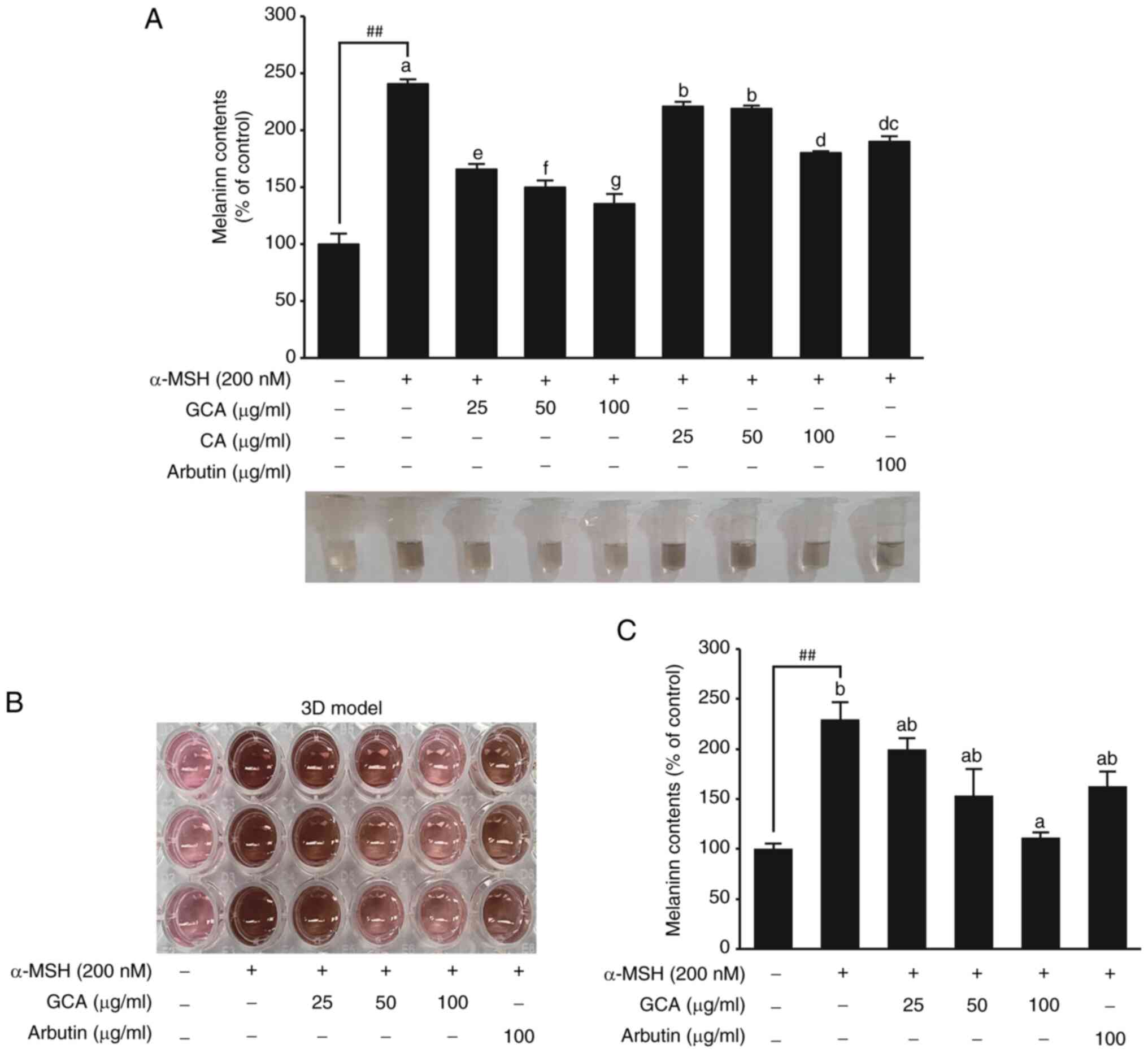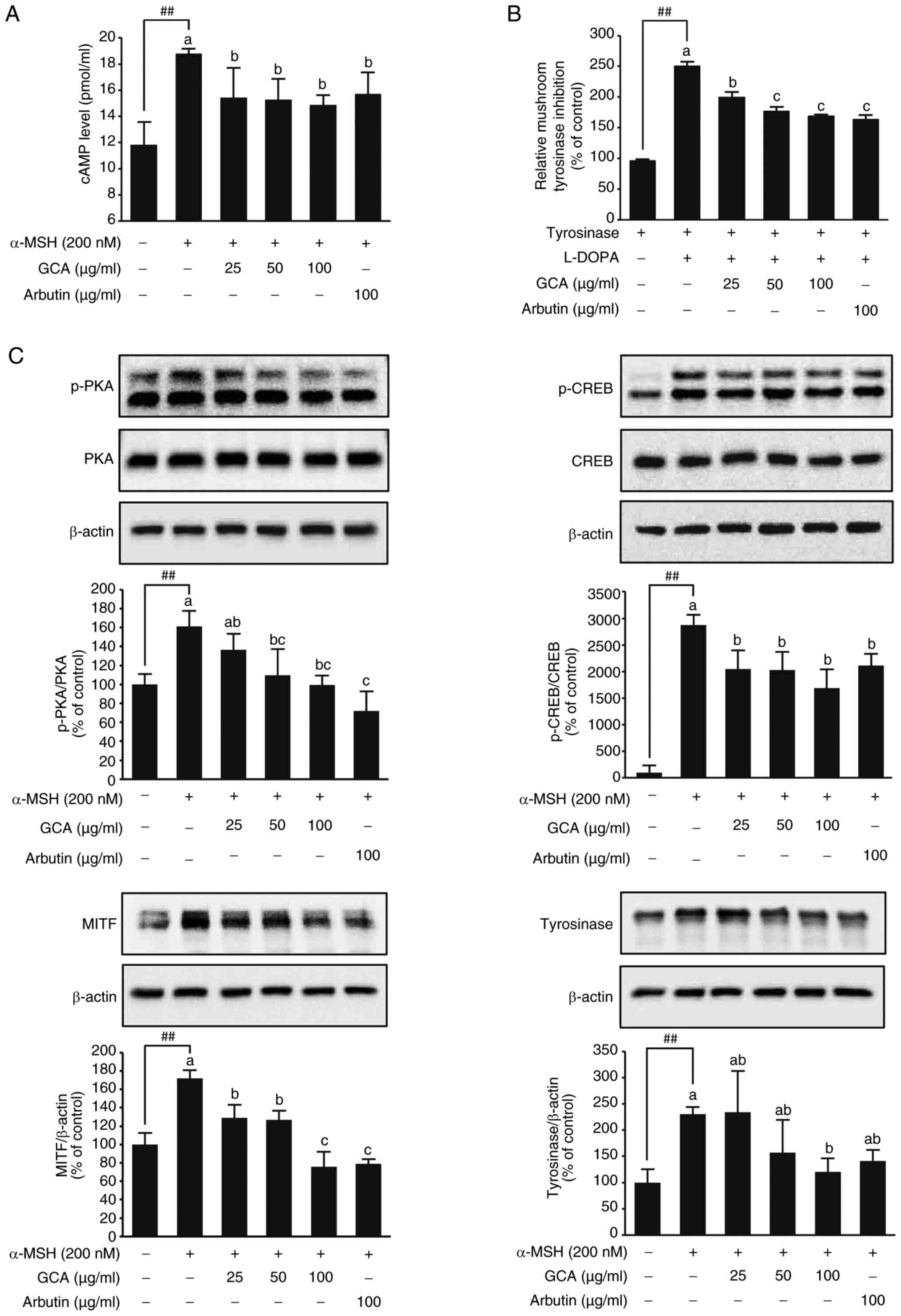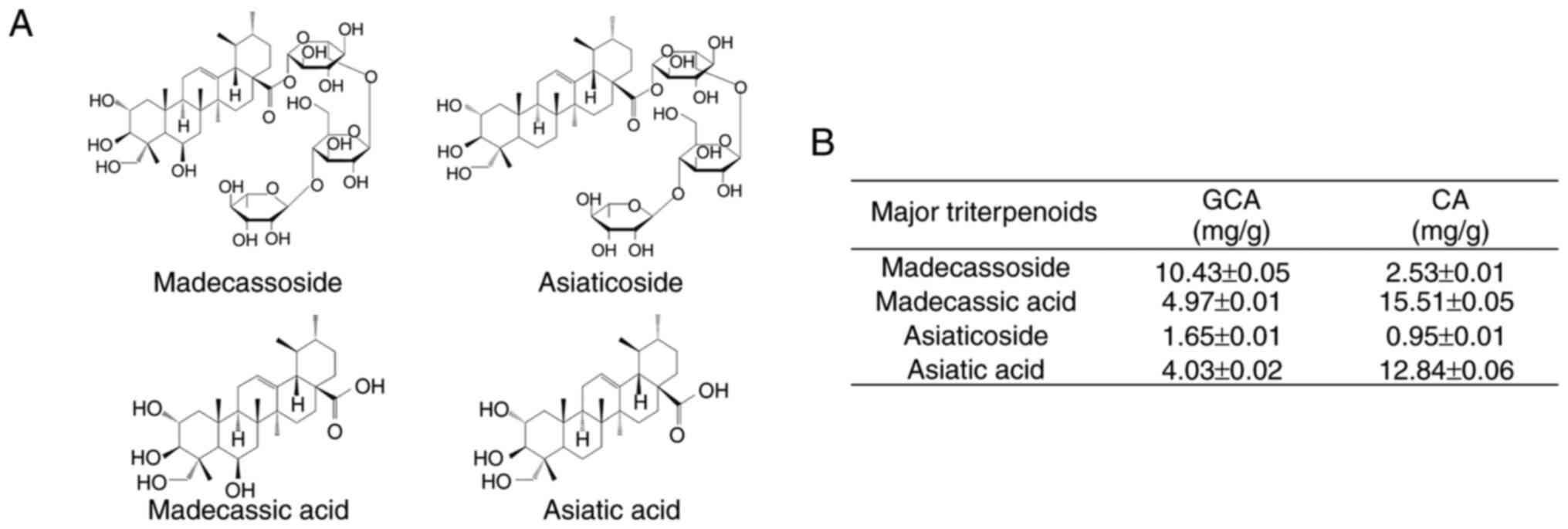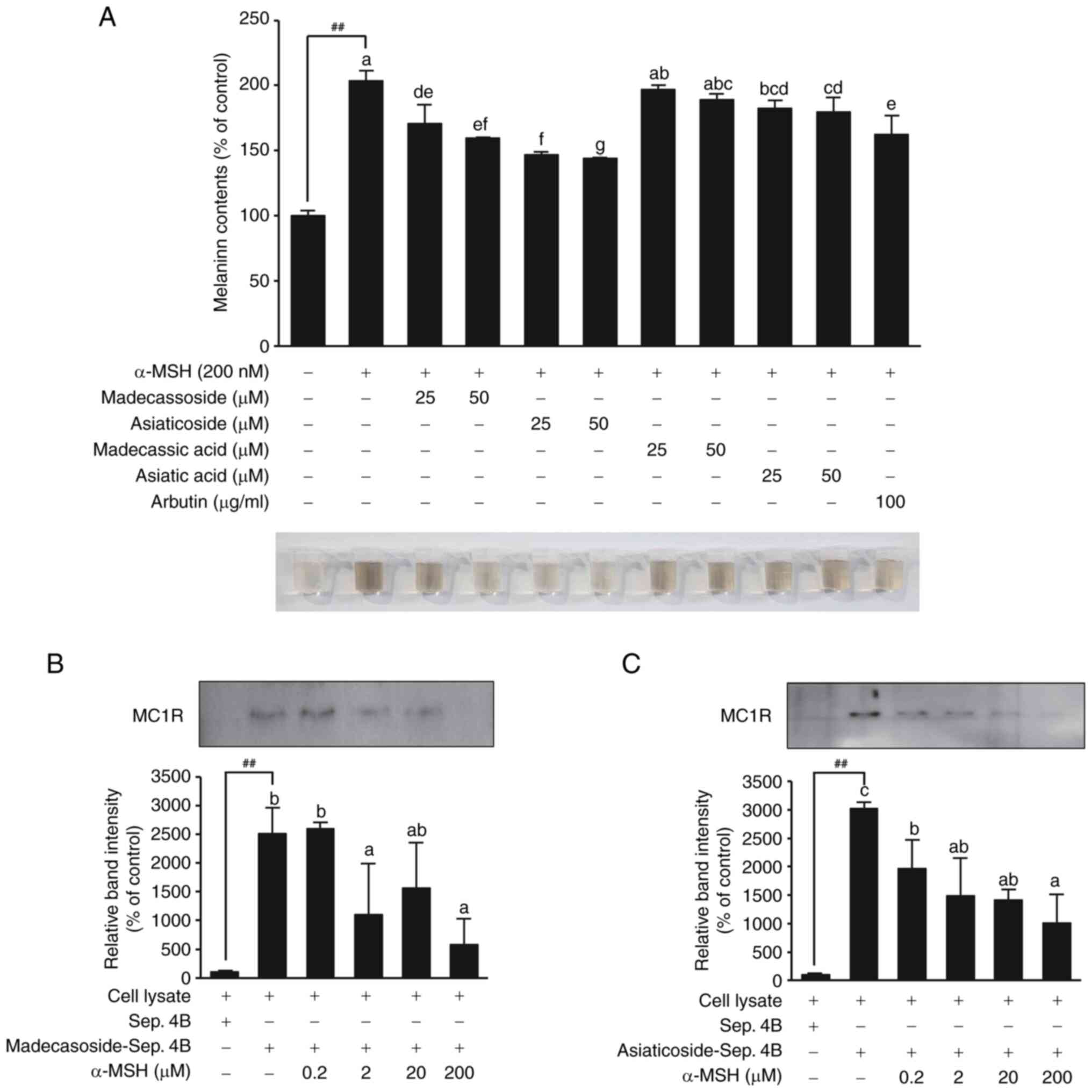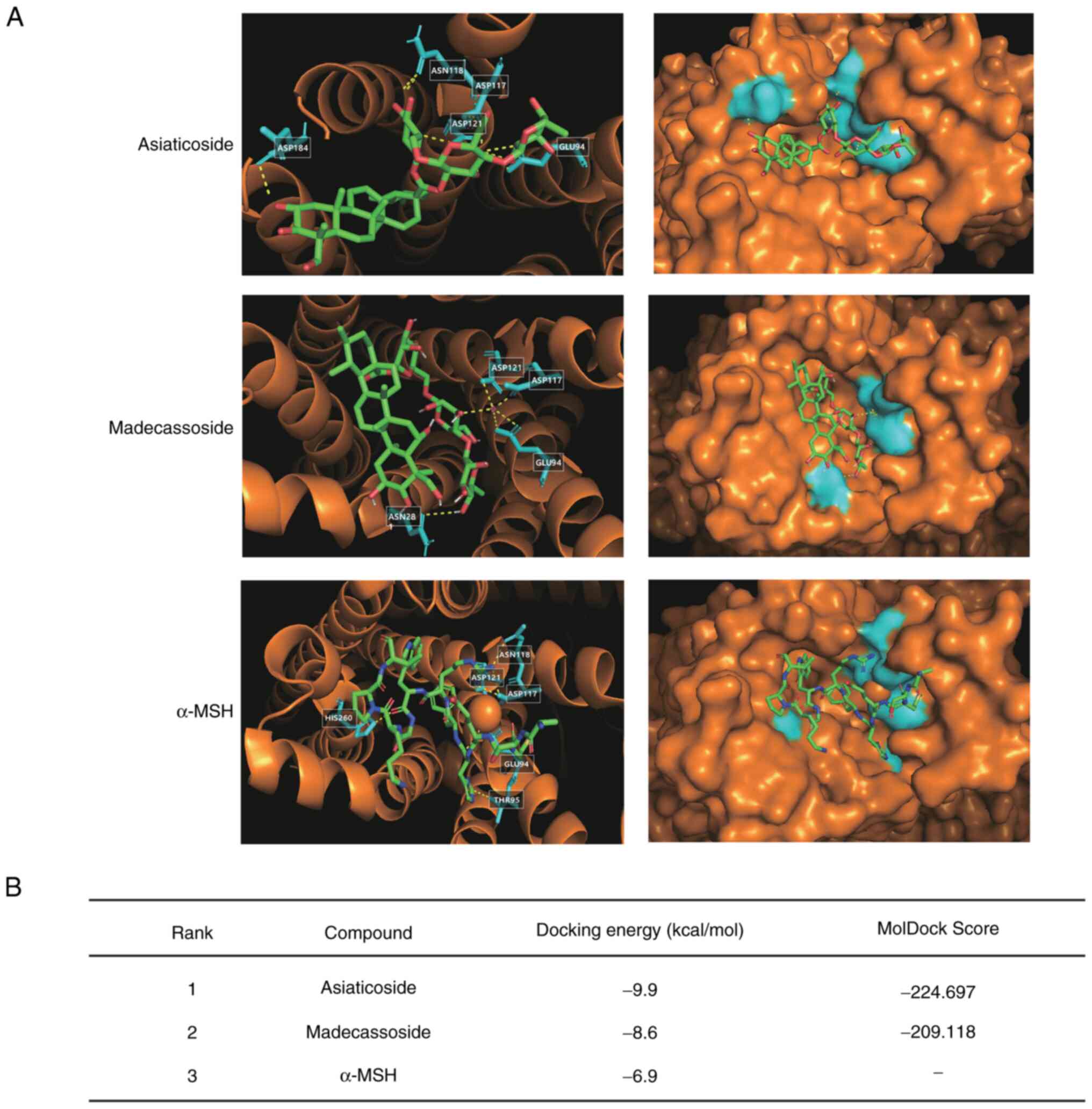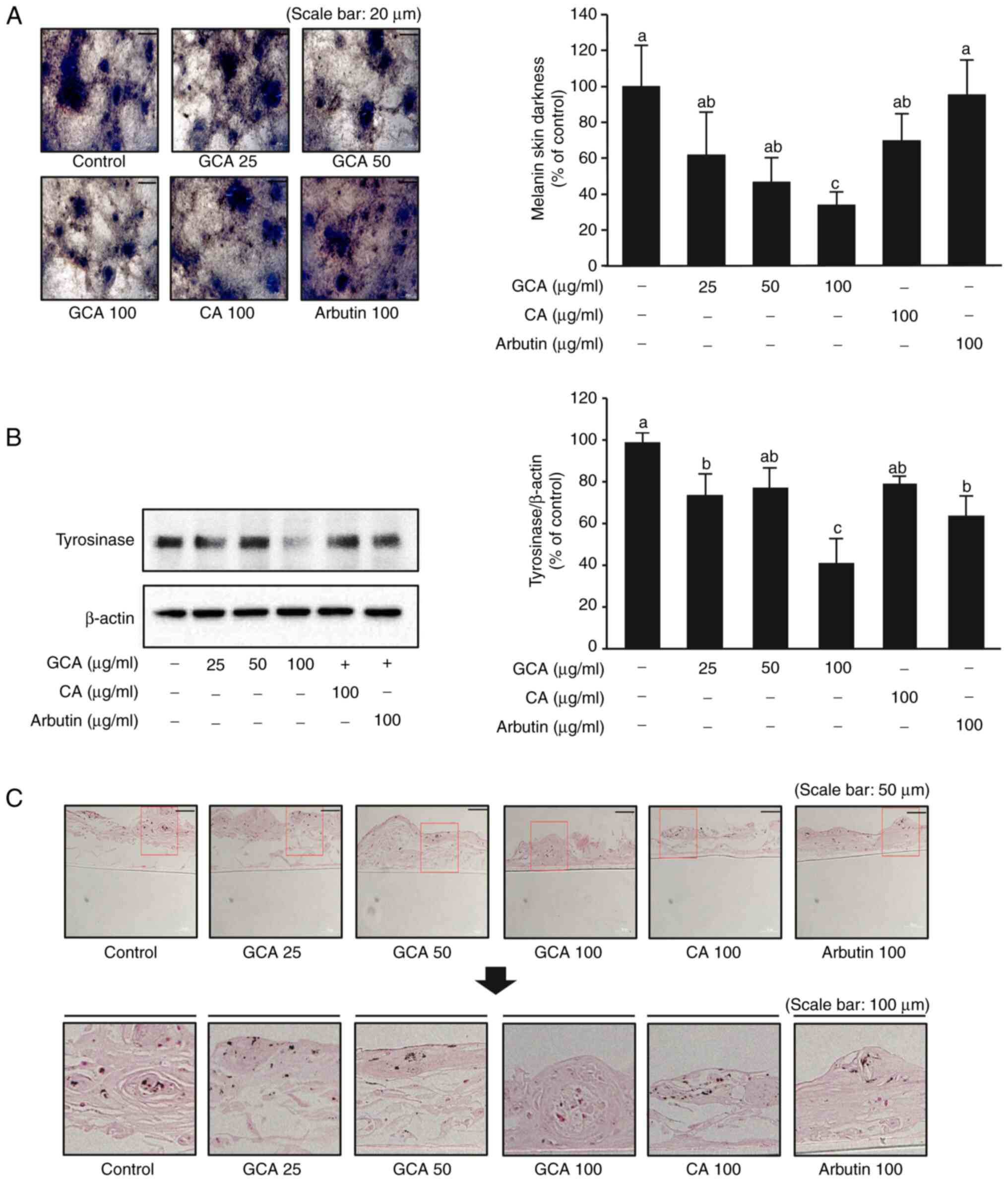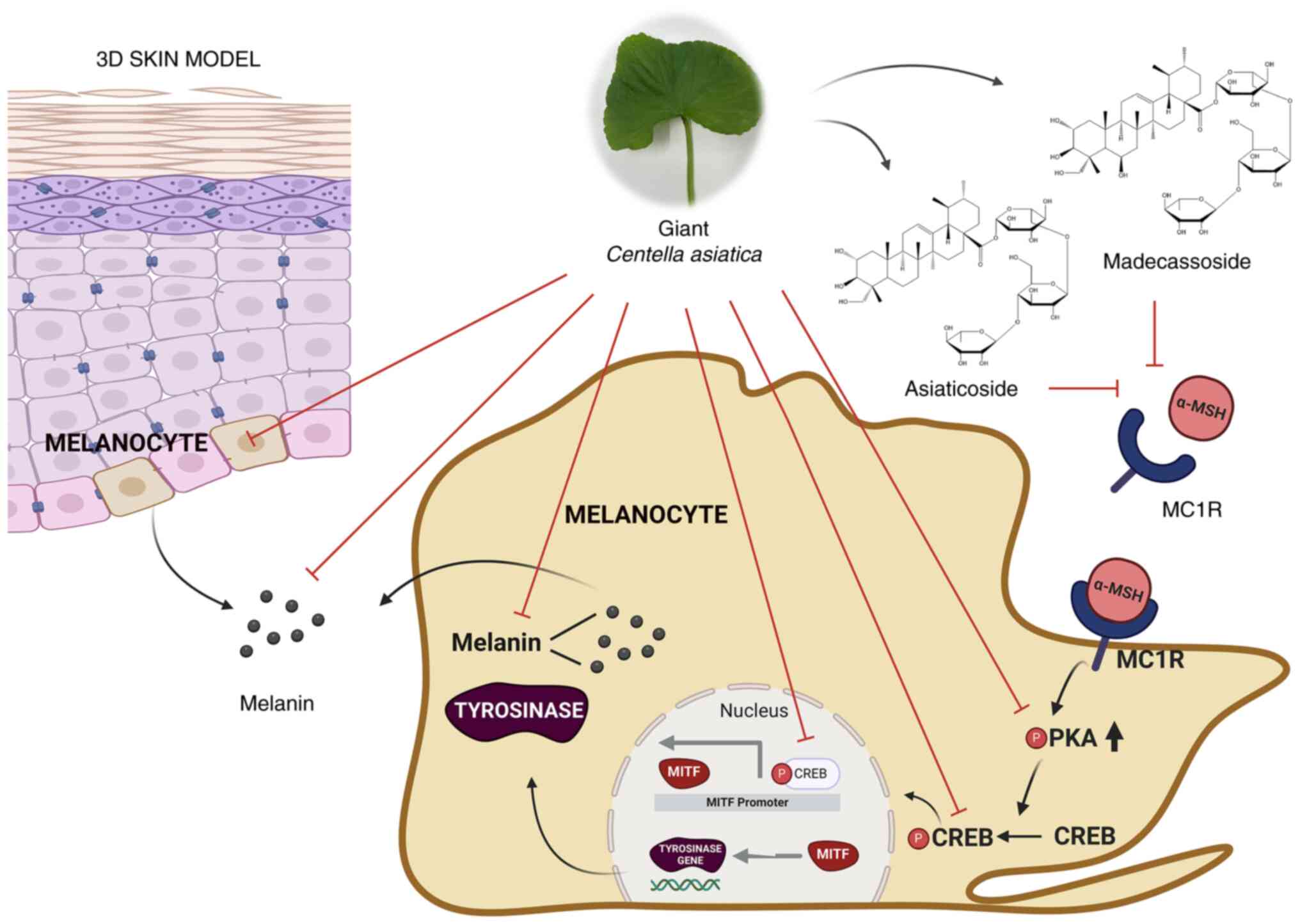|
1
|
Shon YJ, Kim WC, Lee SH, Hong S, Kim SY,
Park MH, Lee P, Lee J, Park KH, Lim W and Lim TG: Antimelanogenic
potential of brewer's spent grain extract through modulation of the
MAPK/MITF axis. Sustain. Mater. Technol. 38:e007212023.
|
|
2
|
Hong S, Lee S, Sim WJ, Kim WC, Kim SY,
Park MH, Lim W and Lim TG: Ultrasound-assisted pumpkin tendril
extracts inhibits melanogenesis by suppressing the CREB/MITF
signaling pathway in B16F10 melanoma cells, zebrafish, and a human
skin model. J Funct Foods. 109:1058132023. View Article : Google Scholar
|
|
3
|
Ito S; IFPCS: The IFPCS presidential
lecture: A chemist's view of melanogenesis. Pigment Cell Res.
16:230–236. 2003. View Article : Google Scholar : PubMed/NCBI
|
|
4
|
Videira IF, Moura DF and Magina S:
Mechanisms regulating melanogenesis. An Bras Dermatol. 88:76–83.
2013. View Article : Google Scholar : PubMed/NCBI
|
|
5
|
Böhm M, Wolff I, Scholzen TE, Robinson
SJ, Healy E, Luger TA, Schwarz T and Schwarz A:
alpha-Melanocyte-stimulating hormone protects from ultraviolet
radiation-induced apoptosis and DNA damage. J Biol Chem.
280:5795–5802. 2005. View Article : Google Scholar
|
|
6
|
García-Borrón JC, Abdel-Malek Z and
Jiménez-Cervantes C: MC1R, the cAMP pathway, and the response to
solar UV: Extending the horizon beyond pigmentation. Pigment Cell
Melanoma Res. 27:699–720. 2014. View Article : Google Scholar : PubMed/NCBI
|
|
7
|
Dessinioti C, Antoniou C, Katsambas A and
Stratigos AJ: Melanocortin 1 receptor variants: functional role and
pigmentary associations. Photochem Photobiol. 87:978–987. 2011.
View Article : Google Scholar : PubMed/NCBI
|
|
8
|
Park HY, Wu C, Yonemoto L, Murphy-Smith M,
Wu H, Stachur CM and Gilchrest BA: MITF mediates cAMP-induced
protein kinase C-beta expression in human melanocytes. Biochem J.
395:571–578. 2006. View Article : Google Scholar : PubMed/NCBI
|
|
9
|
Shin H, Hong SD, Roh E, Jung SH, Cho WJ,
Park SH, Yoon DY, Ko SM, Hwang BY, Hong JT, et al: cAMP-dependent
activation of protein kinase A as a therapeutic target of skin
hyperpigmentation by diphenylmethylene hydrazinecarbothioamide. Br
J Pharmacol. 172:3434–3445. 2015. View Article : Google Scholar : PubMed/NCBI
|
|
10
|
Zhang H, Kong Q, Wang J, Jiang Y and Hua
H: Complex roles of cAMP-PKA-CREB signaling in cancer. Exp Hematol
Oncol. 9:322020. View Article : Google Scholar : PubMed/NCBI
|
|
11
|
Taylor SS, Kim C, Cheng CY, Brown SH, Wu J
and Kannan N: Signaling through cAMP and cAMP-dependent protein
kinase: Diverse strategies for drug design. Biochim Biophys Acta.
1784:16–26. 2008. View Article : Google Scholar :
|
|
12
|
Ahmed MB, Alghamdi AAA, Islam SU, Lee JS
and Lee YS: cAMP Signaling in Cancer: A PKA-CREB and EPAC-Centric
Approach. Cells. 11:20202022. View Article : Google Scholar : PubMed/NCBI
|
|
13
|
Hartman ML and Czyz M: MITF in melanoma:
Mechanisms behind its expression and activity. Cell Mol Life Sci.
72:1249–1260. 2015. View Article : Google Scholar :
|
|
14
|
Gelmi MC, Houtzagers LE, Strub T, Krossa I
and Jager MJ: Mitf in normal melanocytes, cutaneous and uveal
melanoma: A delicate balance. Int J Mol Sci. 23:60012022.
View Article : Google Scholar : PubMed/NCBI
|
|
15
|
Pillaiyar T, Manickam M and Namasivayam V:
Skin whitening agents: Medicinal chemistry perspective of
tyrosinase inhibitors. J Enzyme Inhib Med Chem. 32:403–425. 2017.
View Article : Google Scholar : PubMed/NCBI
|
|
16
|
Mohania D, Chandel S, Kumar P, Verma V,
Digvijay K, Tripathi D, Choudhury K, Mitten SK and Shah D:
Ultraviolet Radiations: Skin defense-damage mechanism. Adv Exp Med
Biol. 996:71–87. 2017. View Article : Google Scholar : PubMed/NCBI
|
|
17
|
Zamudio Díaz DF, Busch L, Kröger M, Klein
AL, Lohan SB, Mewes KR, Vierkotten L, Witzel C, Rohn S and Meinke
MC: Significance of melanin distribution in the epidermis for the
protective effect against UV light. Sci Rep. 14:34882024.
View Article : Google Scholar : PubMed/NCBI
|
|
18
|
Torbati FA, Ramezani M, Dehghan R, Amiri
MS, Moghadam AT, Shakour N, Elyasi S, Sahebkar A and Emami SA:
Ethnobotany, phytochemistry and pharmacological features of
Centella asiatica: A comprehensive review. Adv Exp Med Biol.
1308:451–499. 2021. View Article : Google Scholar : PubMed/NCBI
|
|
19
|
Bylka W, Znajdek-Awiżeń P,
Studzińska-Sroka E and Brzezińska M: Centella asiatica in
cosmetology. Postepy Dermatol Alergol. 30:46–49. 2013. View Article : Google Scholar : PubMed/NCBI
|
|
20
|
Sun B, Wu L, Wu Y, Zhang C, Qin L, Hayashi
M, Kudo M, Gao M and Liu T: Therapeutic potential of Centella
asiatica and its triterpenes: A review. Front Pharmacol.
11:5680322020. View Article : Google Scholar : PubMed/NCBI
|
|
21
|
Park KS: Pharmacological effects of
Centella asiatica on skin diseases: Evidence and possible
mechanisms. Evid Based Complement Alternat Med. 2021:54626332021.
View Article : Google Scholar : PubMed/NCBI
|
|
22
|
Idana F, Putra WAAG and Winarti NW:
Centella asiatica extract cream inhibited microphthalmia-associated
transcription factor (MITF) expression and prevented melanin amount
increase in Guinea pig skin exposed to ultraviolet-B. Neurologico
Spinale Medico Chirurgico. 5:27–31. 2022.
|
|
23
|
Bylka W, Znajdek-Awiżeń P,
Studzińska-Sroka E, Dańczak-Pazdrowska A and Brzezińska M: Centella
asiatica in dermatology: An overview. Phytother Res. 28:1117–1124.
2014. View Article : Google Scholar : PubMed/NCBI
|
|
24
|
Gohil KJ, Patel JA and Gajjar AK:
Pharmacological review on Centella asiatica: A potential herbal
cure-all. Indian J Pharm Sci. 72:546–556. 2010. View Article : Google Scholar
|
|
25
|
Oh S, Park S, Lee S, Park Y, Jang KI, Yu
KW, Kim D and Shin H: Comparison of growth characteristics and
physiological activity of two Centella asiatica cultivars in
greenhouse soil culture. J Bio-Environ Control. 30:351–358. 2021.
View Article : Google Scholar
|
|
26
|
Park H, Seo JW, Lee TK, Kim JH, Kim JE,
Lim TG, Park JHY, Huh CS, Yang H and Lee KW: Ethanol extract of
Yak-Kong fermented by lactic acid bacteria from a Korean infant
markedly reduces matrix metallopreteinase-1 expression induced by
solar ultraviolet irradiation in human keratinocytes and a 3D skin
model. Antioxidants (Basel). 10:2912021. View Article : Google Scholar : PubMed/NCBI
|
|
27
|
Valdés-Tresanco MS, Valdés-Tresanco ME,
Valiente PA and Moreno E: AMDock: A versatile graphical tool for
assisting molecular docking with Autodock Vina and Autodock4. Biol
Direct. 15:122020. View Article : Google Scholar : PubMed/NCBI
|
|
28
|
Kim JH, Lee JE, Kim T, Yeom MH, Park JS,
di Luccio E, Chen H, Dong Z, Lee KW and Kang NJ: 7, 3′,
4′-trihydroxyisoflavone, a metabolite of the soy isoflavone
daidzein, suppresses α-melanocyte-stimulating hormone-induced
melanogenesis by targeting melanocortin 1 receptor. Front Mol
Biosci. 7:5772842020. View Article : Google Scholar
|
|
29
|
Javed A, Alam MB, Naznin M, Ahmad R, Lee
CH, Kim S and Lee SH: RSM-and ANN-based multifrequency ultrasonic
extraction of polyphenol-rich Sargassum horneri extracts exerting
antioxidative activity via the regulation of MAPK/Nrf2/HO-1
machinery. Antioxidants (Basel). 13:6902024. View Article : Google Scholar
|
|
30
|
Nam G, An SK, Park IC, Bae S and Lee JH:
Daphnetin inhibits α-MSH-induced melanogenesis via PKA and ERK
signaling pathways in B16F10 melanoma cells. Biosci Biotechnol
Biochem. 86:596–609. 2022. View Article : Google Scholar : PubMed/NCBI
|
|
31
|
Yoon Y, Bae S, Kim TJ, An S and Lee JH:
Nodakenin inhibits melanogenesis Via the ERK/MSK1 Signaling
Pathway. Pharmazie. 78:6–12. 2023.PubMed/NCBI
|
|
32
|
Bahraman AG, Jamshidzadeh A, Keshavarzi M,
Arabnezhad MR, Mohammadi H and Mohammadi-Bardbori A:
α-Melanocytestimulating hormone triggers melanogenesis via
activation of the aryl hydrocarbon receptor pathway in B16F10 mouse
melanoma cells. Int J Toxicol. 40:153–160. 2021. View Article : Google Scholar : PubMed/NCBI
|
|
33
|
Seo GY, Ha Y, Park AH, Kwon OW and Kim YJ:
Leathesia difformis extract inhibits α-MSH-induced melanogenesis in
B16F10 cells via down-regulation of CREB signaling pathway. Int J
Mol Sci. 20:5362019. View Article : Google Scholar
|
|
34
|
Kim DH, Shin DW and Lim BO: Fermented
Aronia melanocarpa inhibits melanogenesis through dual mechanisms
of the PI3K/AKT/GSK-3β and PKA/CREB pathways. Molecules.
28:29812023. View Article : Google Scholar
|
|
35
|
Kim MJ, Mohamed EA, Kim DS, Park MJ, Ahn
BJ, Jeung EB and An BS: Inhibitory effects and underlying
mechanisms of Artemisia capillaris essential oil on melanogenesis
in the B16F10 cell line. Mol Med Rep. 25:1132022. View Article : Google Scholar :
|
|
36
|
Wu PY, You YJ, Liu YJ, Hou CW, Wu CS, Wen
KC, Lin CY and Chiang HM: Sesamol inhibited melanogenesis by
regulating melanin-related signal transduction in B16F10 cells. Int
J Mol Sci. 19:11082018. View Article : Google Scholar : PubMed/NCBI
|
|
37
|
Lim YJ, Lee EH, Kang TH, Ha SK, Oh MS, Kim
SM, Yoon TJ, Kang C, Park JH and Kim SY: Inhibitory effects of
arbutin on melanin biosynthesis of alpha-melanocyte stimulating
hormone-induced hyperpigmentation in cultured brownish guinea pig
skin tissues. Arch Pharm Res. 32:367–373. 2009. View Article : Google Scholar : PubMed/NCBI
|
|
38
|
Otręba M, Rok J, Buszman E and Wrześniok
D: Regulation of melanogenesis: the role of cAMP and MITF. Postepy
Hig Med Dosw (Online). 66:33–40. 2012.In Polish.
|
|
39
|
Kwon KJ, Bae S, Kim K, An IS, Ahn KJ, An S
and Cha HJ: Asiaticoside, a component of Centella asiatica,
inhibits melanogenesis in B16F10 mouse melanoma. Mol Med Rep.
10:503–507. 2014. View Article : Google Scholar : PubMed/NCBI
|
|
40
|
Jung E, Lee JA, Shin S, Roh KB, Kim JH and
Park D: Madecassoside inhibits melanin synthesis by blocking
ultraviolet-induced inflammation. Molecules. 18:15724–15736. 2013.
View Article : Google Scholar : PubMed/NCBI
|
|
41
|
Prusis P, Schiöth HB, Muceniece R, Herzyk
P, Afshar M, Hubbard RE and Wikberg JE: Modeling of the
three-dimensional structure of the human melanocortin 1 receptor,
using an automated method and docking of a rigid cyclic
melanocyte-stimulating hormone core peptide. J Mol Graph Model.
15:307–317.334. 1997. View Article : Google Scholar
|
|
42
|
Yang CW, Ran JS, Yu CL, Qiu MH, Zhang ZR,
Du HR, Li QY, Xiong X, Song XY, Xia B, et al: Polymorphism in MC1R,
TYR and ASIP genes in different colored feather chickens. 3
Biotech. 9:2032019. View Article : Google Scholar : PubMed/NCBI
|
|
43
|
Gallina L, Cravotto C, Capaldi G, Grillo G
and Cravotto G: Plant extraction in water: Towards highly efficient
industrial applications. Processes. 10:22332022. View Article : Google Scholar
|



